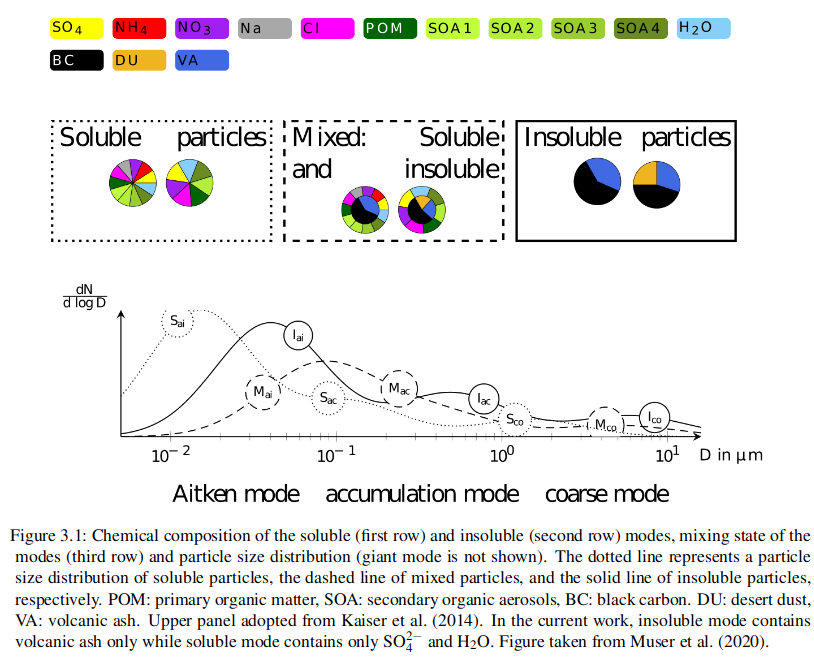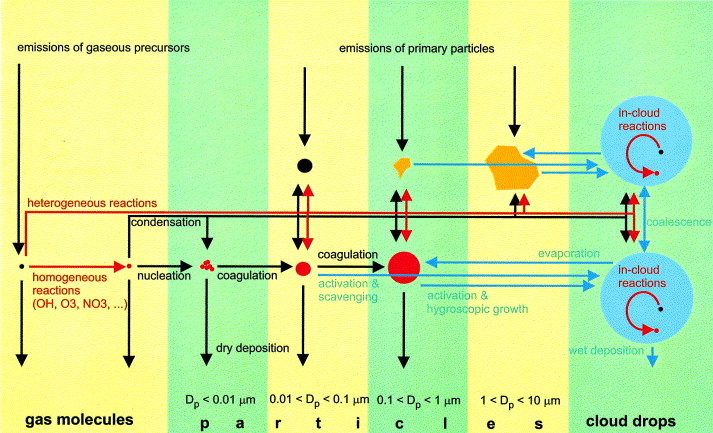AERODYN
AERODYN (AEROsol DYNamics) is a new aerosol dynamics module used in ICON-ART. With AERODYN, secondary aerosol formations (e.g. the accumulation of SO2 on a volcanic ash particle) can be accounted for. Aerosol dynamic processes are the processes which change an aerosols properties after it has been released into the atmosphere. This change of properties (omitting chemical reactions) occurs either via condensation or coagulation. Since it is not feasible to account for every individual aerosol to calculate their movement, coagulation and condensation, AERODYN uses a total of 12 categories for aerosol modes.
Aerosol Modes in AERODYN
Traditionally, There are three categories to account for the aerosol sizes Whitby et. Al. (1978) : Aitken mode, accumulation mode and coarse mode. In AERODYN there is also a fourth mode, called giant mode, which accounts for especially large Aerosols, e.g. some species of pollen.
Since condensation can occur on a solid aerosol particle, as well as for a number of other reasons, it is possible to obtain aerosol modes which are a mixture of solid and liquid modes. To account for this, AERODYN combines 4 modes of aerosol size with the 3 modes soluble, insoluble and mixed. A Visual Representation is given here:
when also adding the giant mode, the following configurations are possible:
AERODYN mode configurations aitken accumulation coarse giant soluble sol_aitken sol_acc sol_coarse sol_giant insoluble insol_aitken insol_acc insol_coarse insol_giant mixed mixed_aitken mixed_acc mixed_coarse mixed_giant
Condensation, Nucleation and Accumulation Processes
Here is a quick reminder of the different aerosol processes:
- Condensation is the process of a gas turning into a liquid. In practice, some sort of surface, or condensation nucleus is needed to enable the phase change.
- Nucleation is the process of an aerosol particle forming from a gaseous phase by random collisions of the gas molecules. The produced aerosol sizes are in the Aitken mode.
- Accumulation in the Process of the initial nucleus growing in size through collision and deposition Processes.
A schematic overview of the different microphysical aerosol processes can be found in the following Figure from Raes et. Al(2000):
In AERODYN, some modes are treated differently with respect to the dynamic processes: Nucleation is only considered for the Aitken mode, and the Giant mode is not affected by condensation. This is done to save computing power while still retaining realism, and since Nucleation of larger Particles without first having Aitken mode Aerosols is highly unlikely, this is a good approximation. Also, as condensation highly prefers smaller modes to the giant mode, this also is a reasonable way to save computing power. For details how the processes are calculated, see Riemer et Al. (2003) and Vogel et. Al. (2009).
Defining Aerosols with AERODYN
AERODYN is meant to be as flexible as possible, allowing the user to quickly define their own aerosols and then use ICON-ART to simulate their dynamics. Aerosols are defined in .xml files, which can then be included in the run by specifying their path in the runfile (see Input for more details)
There are several Types of .xml files for different applications. The most important/most used .xml files are compiled in the following paragraphs.
Defining Tracers
Below is the tracers.xml, where the aerosols as well as their properties are defined. The properties to be defined are listed in the following table.
tracers.xml Parameters Parameter type description example aerosol id char specifies name of the aerosol "my_first_aerosol" moment int this is the moment of the log-normal distribution (0 for number concentration and 3 for mass mixing ratio) 3 mode char mode name from AERODYN mode configurations (multiple modes can be given, seperated by a comma) insol_giant,sol_aitken mol_weight real specify the molar mass 30E-3 rho real specify the density in terms of unit2e3 unit char specify what unit the aerosol will have kg-1 transport char specify transport scheme to be used hadv52aero
Example File of tracers.xml:
<tracers>
<aerosol id="nmb">
<moment type="int">0</moment>
<mode type="char">insol_acc,insol_coa,sol_acc,sol_coa,mixed_acc,mixed_coa</mode>
<unit type="char">kg-1</unit>
<transport type="char">hadv52aero</transport>
</aerosol>
<aerosol id="dust">
<moment type="int">3</moment>
<mode type="char">insol_acc,insol_coa,mixed_acc,mixed_coa</mode>
<sol type="real">0.0</sol>
<mol_weight type="real">50.00E-3</mol_weight>
<rho type="real">2.650E3</rho>
<unit type="char">mug kg-1</unit>
<transport type="char">hadv52aero</transport>
</aerosol>
<aerosol id="na">
<moment type="int">3</moment>
<mode type="char">sol_acc,sol_coa,mixed_acc,mixed_coa</mode>
<sol type="real">1.</sol>
<mol_weight type="real">22.9898E-3</mol_weight>
<rho type="real">2.2E+3</rho>
<unit type="char">mug kg-1</unit>
<transport type="char">hadv52aero</transport>
</aerosol>
<aerosol id="cl">
<moment type="int">3</moment>
<mode type="char">sol_acc,sol_coa,mixed_acc,mixed_coa</mode>
<sol type="real">1.</sol>
<mol_weight type="real">35.453E-3</mol_weight>
<rho type="real">2.2E+3</rho>
<unit type="char">mug kg-1</unit>
<transport type="char">hadv52aero</transport>
</aerosol>
<aerosol id="h2o">
<moment type="int">3</moment>
<mode type="char">sol_acc,sol_coa</mode>
<sol type="real">1.</sol>
<mol_weight type="real">18.01528E-3</mol_weight>
<rho type="real">1.E3</rho>
<unit type="char">mug kg-1</unit>
<transport type="char">off</transport>
</aerosol>
</tracers>
Defining Modes
In the modes.xml the modes which are going to be used in the simulation can be defined. The following .xml contains the same information as Figure 3.1, but in a way the computer can interpret it.
modes.xml Parameters Parameter type description example aerosol id char specifies name of the aerosol "my_first_aerosol" kind char specifies which properties are to be calculated in the model (eg 2mom -> mass mixing ratio and number concentration) 2mom d_gn real median diameter of the lognormal aerosol distribution 2.0E-6 sigma_g real standard deviation of the lognormal aerosol distribution 2.2 condensation int switch to control if condensation can occur 0 icoag int switch to control if coagulation can occur 0 shift2larger char prevents mode from getting to large, then shifts size to given mode (mostly used for Aitken mode) insol_acc shift_diam real defines the diameter where the aerosol is shifted to the given mode 0.08E-6 shift2mixed char shift to given mode when 5% of mass is liquid mixed_coa
Sometimes it is necessary for the type of an aerosol to change its given mode if its diameter gets too large or a large amount of condensation occurs. The mass can then be transferred to defined modes, as seen in the table above.
Example File of modes.xml:
<modes>
<aerosol id="sol_acc">
<kind type="char">2mom</kind>
<d_gn type="real">0.2E-6</d_gn>
<sigma_g type="real">2.0</sigma_g>
<condensation type="int">0</condensation>
<icoag type="int">1</icoag>
</aerosol>
<aerosol id="insol_acc">
<kind type="char">2mom</kind>
<d_gn type="real">6.445E-7</d_gn>
<sigma_g type="real">1.700E+0</sigma_g>
<condensation type="int">0</condensation>
<shift2mixed type="char">mixed_acc</shift2mixed>
<icoag type="int">1</icoag>
</aerosol>
<aerosol id="mixed_acc">
<kind type="char">2mom</kind>
<d_gn type="real">6.445E-7</d_gn>
<sigma_g type="real">1.700E+0</sigma_g>
<condensation type="int">0</condensation>
<icoag type="int">1</icoag>
</aerosol>
<aerosol id="sol_coa">
<kind type="char">2mom</kind>
<d_gn type="real">2.0E-6</d_gn>
<sigma_g type="real">2.2</sigma_g>
<condensation type="int">0</condensation>
<icoag type="int">1</icoag>
</aerosol>
<aerosol id="insol_coa">
<kind type="char">2mom</kind>
<d_gn type="real">2.0E-6</d_gn>
<sigma_g type="real">2.2</sigma_g>
<condensation type="int">0</condensation>
<shift2mixed type="char">mixed_coa</shift2mixed>
<icoag type="int">1</icoag>
</aerosol>
<aerosol id="mixed_coa">
<kind type="char">2mom</kind>
<d_gn type="real">2.0E-6</d_gn>
<sigma_g type="real">2.2</sigma_g>
<condensation type="int">0</condensation>
<icoag type="int">1</icoag>
</aerosol>
</modes>
Defining Coagulation
Here the behaviour of collision and subsequent merging (coagulation) between aerosols can be defined. If for example a solid (insol) aerosol merges with a liquid (sol) aerosol, the result should logically be a mixed aerosol, and so on. This can further be defined for all sizes of aerosols as seen in the example .xml for accumulation and coarse modes.
coagulate.xml Parameters Parameter type description example smallmode id char The aerosol_mode which is gonig to coagulate insol_acc nmodes int Defines the number of modes for which the coagulation preocesses are defined 5 bigmode id char Inside angle brackets : coagulation partner of the given aerosol mode. Outside angle brackets: the new mode of the cagulated aerosols. <bigmode id="sol_acc" type="char">mixed_acc</bigmode>
Example File of coag.xml:
<coagulate>
<smallmode id="sol_acc">
<nmodes type="int">6</nmodes>
<bigmode id="sol_acc" type="char">sol_acc</bigmode>
<bigmode id="insol_acc" type="char">mixed_acc</bigmode>
<bigmode id="mixed_acc" type="char">mixed_acc</bigmode>
<bigmode id="sol_coa" type="char">sol_coa</bigmode>
<bigmode id="insol_coa" type="char">mixed_coa</bigmode>
<bigmode id="mixed_coa" type="char">mixed_coa</bigmode>
</smallmode>
<smallmode id="insol_acc">
<nmodes type="int">5</nmodes>
<bigmode id="insol_acc" type="char">insol_acc</bigmode>
<bigmode id="mixed_acc" type="char">mixed_acc</bigmode>
<bigmode id="sol_coa" type="char">mixed_coa</bigmode>
<bigmode id="insol_coa" type="char">insol_coa</bigmode>
<bigmode id="mixed_coa" type="char">mixed_coa</bigmode>
</smallmode>
<smallmode id="mixed_acc">
<nmodes type="int">4</nmodes>
<bigmode id="mixed_acc" type="char">mixed_acc</bigmode>
<bigmode id="sol_coa" type="char">mixed_coa</bigmode>
<bigmode id="insol_coa" type="char">mixed_coa</bigmode>
<bigmode id="mixed_coa" type="char">mixed_coa</bigmode>
</smallmode>
<smallmode id="sol_coa">
<nmodes type="int">3</nmodes>
<bigmode id="sol_coa" type="char">sol_coa</bigmode>
<bigmode id="insol_coa" type="char">mixed_coa</bigmode>
<bigmode id="mixed_coa" type="char">mixed_coa</bigmode>
</smallmode>
<smallmode id="insol_coa">
<nmodes type="int">2</nmodes>
<bigmode id="insol_coa" type="char">insol_coa</bigmode>
<bigmode id="mixed_coa" type="char">mixed_coa</bigmode>
</smallmode>
<smallmode id="mixed_coa">
<nmodes type="int">1</nmodes>
<bigmode id="mixed_coa" type="char">mixed_coa</bigmode>
</smallmode>
</coagulate>
Defining the Model Output
In the diagnostics.xml the diagnostic variables that can be written out are defined. Below are some examples, however this is a heavily shortened version of the diagnostics.xml used in ICON-ART.
Example File of diagnostics.xml:
<diagnostics>
<aerosol id="diam_insol_acc">
<productDefinitionTemplate type="int">40</productDefinitionTemplate>
<discipline type="int">0</discipline>
<parameterCategory type="int">254</parameterCategory>
<parameterNumber type="int">201</parameterNumber>
<constituentType type="int">62001</constituentType>
</aerosol>
<aerosol id="acc_drydepo">
<tracername_list type="char">dust_insol_acc,dust_insol_coa,na_sol_acc,na_sol_coa,cl_sol_acc,cl_sol_coa,nmb_sol_acc,nmb_sol_coa,nmb_insol_acc,nmb_insol_coa</tracername_list>
<parameterNumber_list type="char">6,6,6,6,6,6,192,192,192,192</parameterNumber_list>
<productDefinitionTemplate_list type="char">67,67,67,67,67,67,67,67,67,67</productDefinitionTemplate_list>
<typeOfStatisticalProcessing type="int">1</typeOfStatisticalProcessing>
<bitsPerValue type="int">32</bitsPerValue>
<typeOfDistributionFunction type="int">8</typeOfDistributionFunction>
<numberOfModeOfDistribution type="int">3</numberOfModeOfDistribution>
<numberOfDistributionFunctionParameters type="int">2</numberOfDistributionFunctionParameters>
</aerosol>
<aerosol id="acc_emiss">
<tracername_list type="char">dust_insol_acc,dust_insol_coa,na_sol_acc,na_sol_coa,cl_sol_acc,cl_sol_coa,nmb_sol_acc,nmb_sol_coa,nmb_insol_acc,nmb_insol_coa</tracername_list>
<parameterNumber_list type="char">3,3,3,3,3,3,3,3,3,3</parameterNumber_list>
<productDefinitionTemplate_list type="char">67,67,67,67,67,67,67,67,67,67</productDefinitionTemplate_list>
<typeOfStatisticalProcessing type="int">1</typeOfStatisticalProcessing>
<bitsPerValue type="int">32</bitsPerValue>
<typeOfDistributionFunction type="int">8</typeOfDistributionFunction>
<numberOfModeOfDistribution type="int">3</numberOfModeOfDistribution>
<numberOfDistributionFunctionParameters type="int">2</numberOfDistributionFunctionParameters>
</aerosol>
</diagnostics>
Defining the Aerosol Emissions
Aerosol emissions can be defined via the aero_emiss.xml. Here you do not define the modes themselves but the distribution of the aerosols. ICON-ART then maps the given distribution on to the best fitting modes.
aero_emiss.xml Parameters Parameter type description example routine id char define the name of the emission routine dust nmodes int number of aerosol modes to be emitted. The "X" in the following is to replaced by the numbers 1 to nmodes. 3 d_g0_X real median diameter weighted by number concentration. Has to be defined for every mode given by nmodes. 6.445E-7 d_g3_X real median diameter weighted by mass concentration. Has to be defined for every mode given by nmodes. 1.500E-6 rho real Density of the emitted aerosol 2.2E3 substances char name of the tracers about to be emitted na,cl
Example File of aero_emiss.xml:
<emiss>
<routine id="dust">
<nmodes type="int">3</nmodes>
<d_g0_1 type="real">6.445E-7</d_g0_1>
<d_g3_1 type="real">1.500E-6</d_g3_1>
<sigma_g_1 type="real">1.700E+0</sigma_g_1>
<d_g0_2 type="real">3.454E-6</d_g0_2>
<d_g3_2 type="real">6.700E-6</d_g3_2>
<sigma_g_2 type="real">1.600E+0</sigma_g_2>
<d_g0_3 type="real">8.672E-6</d_g0_3>
<d_g3_3 type="real">1.420E-5</d_g3_3>
<sigma_g_3 type="real">1.500E+0</sigma_g_3>
<rho type="real">2.650E3</rho>
<substances type="char">dust</substances>
</routine>
<routine id="seas_mode1">
<nmodes type="int">1</nmodes>
<d_g0_1 type="real">0.100E-6</d_g0_1>
<d_g3_1 type="real">0.433E-6</d_g3_1>
<sigma_g_1 type="real">1.900E+0</sigma_g_1>
<rho type="real">2.2E3</rho>
<substances type="char">na,cl</substances>
</routine>
<routine id="seas_mode2">
<nmodes type="int">1</nmodes>
<d_g0_1 type="real">3.000E-6</d_g0_1>
<d_g3_1 type="real">1.268E-5</d_g3_1>
<sigma_g_1 type="real">2.000E+0</sigma_g_1>
<rho type="real">2.2E3</rho>
<substances type="char">na,cl</substances>
</routine>
</emiss>

